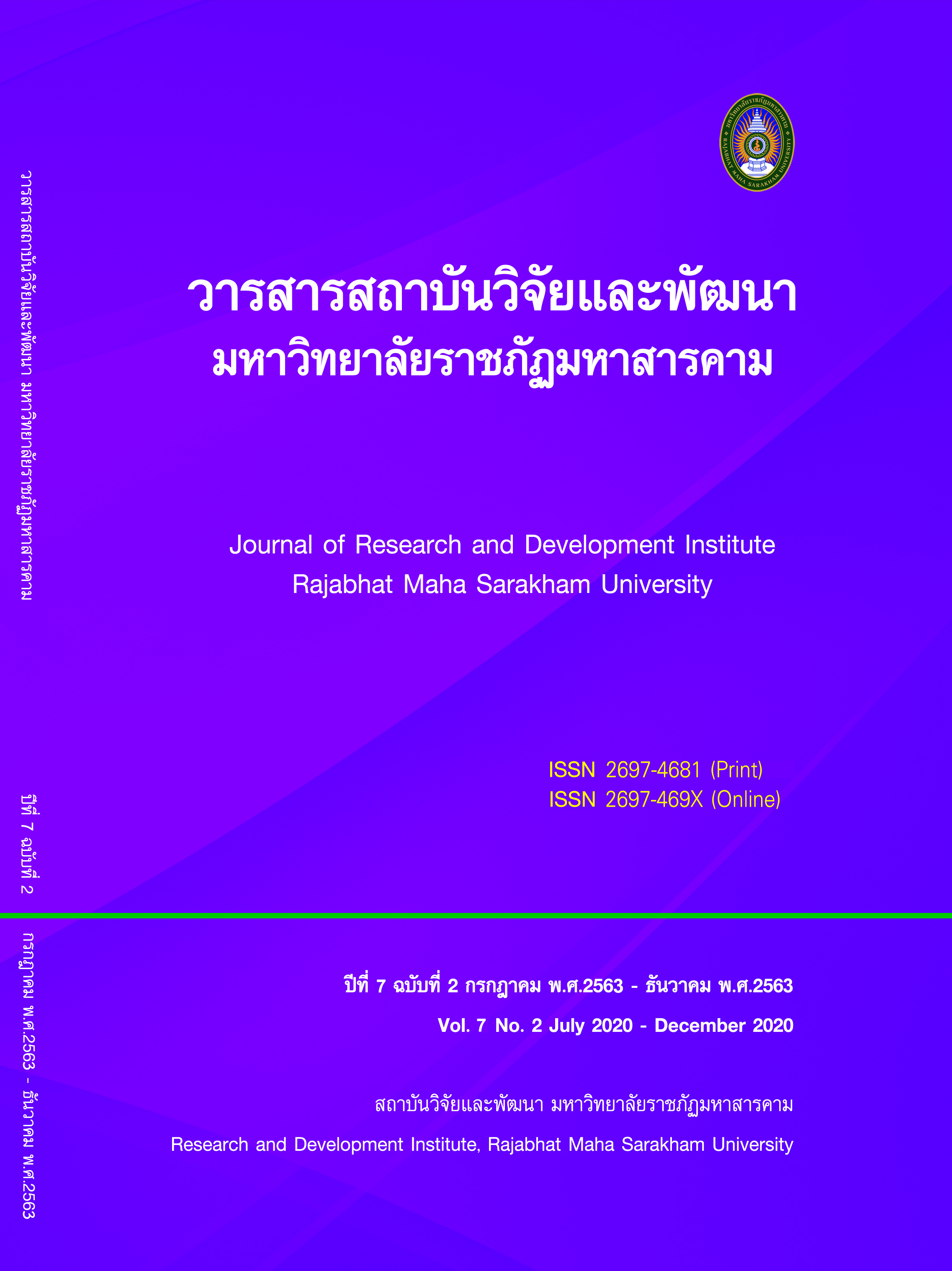Break-even Point and Margin of Safety Analysis In Sugarcane cultivation of Farmers With the introduction of agricultural machinery to be used in Nakhon Sawan Province
Keywords:
Break-Even Point, Margin of Safety, Sugarcane, Agricultural machinery, FarmerAbstract
The objectives of this research were threefold: First, to examine the general situations and the concerning data in terms of using the sugarcane agricultural machine of farmers; Second, to analyze the break-even point and the safety benefit margin of farmers who used the sugarcane agricultural machine for cultivation; and Third, to analyze the basic factors affecting the sugarcane plant of farmers. Three hundred and eighty-four sugarcane farmer questionnaires were collected by the multi-stage random sampling technique. The following statistics were employed: frequency, percentage, means, standard deviation, and the administrative accountancy and principle criterion with occurred behavioral style. Research results found that
1. Most sugarcane farmers were as male (58.30%), aging 41– 45 years-old (26.60%), highest education - sixth grade (39.90%), only one occupation - sugarcane plant (75.80%), sugarcane plant experience during 5 -10 years (46.60%), most financial sources from themselves (39.63%), having moderate area 60-199 Rai for plant (70.30%), most sugarcane as a type of Early rain sugarcane outside the irrigation area (66.15%) and most of new sugarcane (76.38%), every farmers took the agricultural machine for planting (100%), most some agricultural machine invested by farmer and some aspects cooperating with agency (94.33%). Also, an investment for permanent assets or agricultural machines were the average mean as 300,000 Baht.
2. Capital investment and taking the agricultural machine for planting, it revealed that capital divided by behaviors were as follows: Average of adjusted capital per rai as 11,381.08 Baht, consisted of (1) raw materials as sugarcane nursery plants 1,763.18 Baht per Rai; (2) presume labor costs, such as ground preparation 1,360.20 Baht per Rai, nursery plant preparation 367.14 Baht per Rai, plant employment 635.14 Baht per Rai, caring employment 542.36 Baht per Rai, and harvest and transportation prices by using the sugarcane cut off machine 5,203.20 Baht per Rai; (3) other expenses, such as fertilizer 1,026.28 Baht per Rai; drug for get rid of weeds ang bugs 350.16 Baht per Rai; and fuel oil 133.42 Baht per Rai; average of constant capital 1,791.46 Baht per Rai, Rent 1,203.16 Baht per Rai, such as depreciate in value of machines 588.30 Baht per Rai; summary: average of the total capital 13,172.54 Baht per Rai or the capital mean as 810.12 Baht per sugarcane ton. It was also found that the benefits of products in the area 1 Rai had the products 16.26 tons and gave benefit 880.34 Baht per ton at the average of sweet 12.17 C.C.S. (average income as 14,314.33 Baht per Rai, net profit 1,141.79 Baht per Rai). Also, it was found that the plant area 102.27 Rai, break-even point was as 1,662.97 tons or 1,428,571.43 Baht. In this case if farmers could increase products as 18 tons per Rai, they would receive the margin of safety at 9.42 percent.
3. Basic factors affecting the sugarcane planting, it revealed that these aspects had crucial effects on sugarcane planting: men at moderate, budgeting at high, agricultural machine at moderate, and management at moderate levels, average means as 3.15, 3.70, 3.24, and 2.80, respectively.
References
References
Benjamas Apisithpinyo. (2013). Cost Accounting 2. Bangkok: SE-EDUCATION.
Chaya, Wirawat & Bunnag, Boosya & Gheewala, Shabbir. (2018). “Adoption, Cost and Livelihood Impact of Machinery Services Used in Small-Scale Sugarcane Production in Thailand”. Sugar Tech. 1-14. 10.1007/s12355-018-0651-x.
Chompoonuch Wongsuwan. (2012). The Study of Capital Structure of Sugar Cane Production and Logistic to the Factory Case Study : Boasuphan Sub-District, Songpinong District, Suphanburi Province/ Cultivate Year 2011/2012. Bangkok: University of the Chamber of Commerce.
Chulaluck Yoosuk, Paranee Tangwiwat, and Benchamas Yooprasert. (2017). “An Application of Technology in Sugarcane Production and Needs for Extension Services of Farmers in Mueang District, Amnat Charoen Province” KHON KAEN AGR. J. 45 SUPPL : 1597-1604.
Chuleeporn Kusoncum and Kanchana Sethanan. (2012). A Study of Costs and Returns of Sugarcane Production Sent to the Sugar Mill for Small-scale Growers in Buakhao, Kuchinarai District, Kalasin Province. Annual Conference on Industrial Engineering Network 2012, 17-19 October 2012, Cha-am, Phetchaburi. Page 2134-2140. .
Desai, G. S. (2000). Cost and pricing practices in the sugar industry: A study of selected units of Gujarat state (10098775). Available from ProQuest Dissertations & Theses Global. (1782315579). [Online] https://search.proquest.com/docview/1782315579?accountid=44806.
Duangmanee Komaratat. (2016). Cost accounting. 15th edition. Bangkok: Chulalongkorn University Press.
Ketsuda Dejbhimon. (2015). Project to create production costs and transfer knowledge to reduce agricultural sugarcane production costs in the 2014 planting yea : Khon Kaen : Khon Kaen University.
Krejcie, R. V. & Morgan, D. W. (1970). “Determining Sample Size for Research Activities”. Educational and Psychological Measurement, 30 (3) : 607-610.
Nakhon Sawan Provincial Agriculture Office. (2017). Important economic crops. [Online] http://www.bangkokbiznews.com. [19 March 2019].
Office of the Cane and Sugar Board. (2017). Annual Report 2017 Office of the Cane and Sugar Board Production year 2016/2017. Bangkok : Office of the Cane and Sugar Board.
Somnuk Aujirapongpan. (2004). Cost Accounting 2. Bangkok: Physics Center.
Thatsanchai Treesat and Jamnong Jun-iad. (2013). “The Condition of Social and Economic, and the Problem of Growing Sugarcane by Farmers in U-Thong District of Suphan Buri Province” Princess of Naradhiwas University Journal, 5 (4) : 28-37.
Wimonrat Ngokphilai and Supaporn Poungchompu. (2015). STUDY ON COSTS AND RETURNS OF SMALLHOLDER FARMERS USING AGRICULTURAL MECHANIZATION FOR SUGARCANE PRODUCTION FOR SMALLHOLDER FARMERS AT NONGRUA DISTRICT KHONKAEN PROVINCE CASE STUDY:SUGARCANE HARVESTER MACHINERY. Khon Kaen : Faculty of Agriculture, Khon Kaen University.
Downloads
Published
How to Cite
Issue
Section
License
Articles that are published are copyrighted by the authors of the articles







